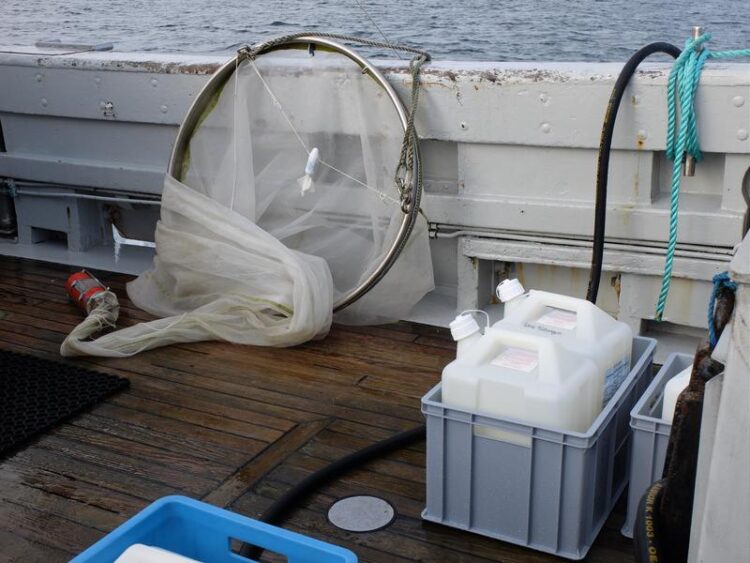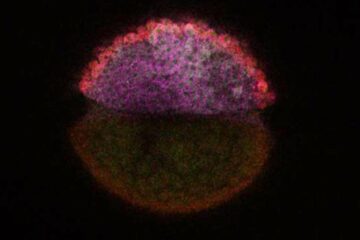Biosurfactants might offer an environmentally friendly solution for tackling oil spills

Sampling on the ship to study seawater from the North Sea. The seawater is filled into large canisters and cooled and brought back to the lab where the microcosm experiments are conducted.
(c) Saskia Rughöft
Can biosurfactants increase microbiological oil degradation in North Sea seawater?
An international research team from the universities of Stuttgart und Tübingen, together with the China West Normal University and the University of Georgia, have been exploring this question and the results have revealed the potential for a more effective and environmentally friendly oil spill response.
Oil leaks into the oceans are estimated at approximately 1500 million liters annually worldwide. This leads to globally significant environmental pollution, as oil contains hazardous compounds such as polycyclic aromatic hydrocarbons that can have toxic or mutagenic effects on organisms. Oil spills, particularly catastrophic ones resulting in the rapid release of large quantities of oil into the oceans, such as tanker accidents or incidents at oil drilling platforms like Deepwater Horizon in 2010, are especially devastating.
In such oil spill incidents, large quantities of chemical dispersants, ranging in the millions of liters depending on the amount of oil, are routinely applied to dissolve oil slicks, prevent oil from reaching coastlines, and enhance oil dispersion in the water. The hope is that microbial oil degradation will be enhanced as a result. This is because special microorganisms that are widespread in nature can feed on crude oil components and break them down into harmless substances. This special ability of microbes naturally cleans oil-contaminated areas.
“In a study from the USA published in 2015, we demonstrated that – contrary to expectation – chemical dispersants in deep-sea water from the Gulf of Mexico can slow down microbial oil degradation,” says Prof. Sara Kleindienst, who worked at the University of Tübingen until 2022 and now works at the University of Stuttgart. “Since then, the topic has been at the center of controversial discussions, and there is still no simple answer to how oil spills can be combated more effectively,” emphasizes Prof. Sara Kleindienst.
In the search for more environmentally friendly methods for dealing with oil spills, biosurfactants could offer a promising alternative to chemical dispersants. Biosurfactants are produced by microorganisms and can increase the bioavailability of oil components. This can thus enhance microbial oil degradation, which is crucial for purification.
Experiments with seawater from the North Sea
An international research team led by environmental microbiologist Professor Sara Kleindienst, with geomicrobiologist Professor Andreas Kappler (University of Tübingen) and biogeochemist Professor Samantha Joye (University of Georgia), compared the effects of biosurfactants and chemical dispersants. In the laboratory at the University of Tübingen, the researchers simulated oil spill conditions. For their experiment, they took over 100 liters of surface water from the North Sea close to the island of Helgoland. The seawater was treated with either the biosurfactant rhamnolipid or a dispersant (either Corexit 9500 or Slickgone NS), both in the presence and absence of oil. The research team used radioactive markers to track the degradation of the oil by the microorganisms in detail. “Our investigations using radioactively labeled hydrocarbons or a radioactively labeled amino acid showed that the highest rates of microbial hydrocarbon oxidation and protein synthesis occurred in the oil microcosms treated with rhamnolipid,” says Prof. Lu Lu, who previously worked at the University of Tübingen and now works at the China West Normal University.
The impact on the composition of microbial communities also differed significantly between the approaches using biosurfactants compared to chemical dispersants. “This result suggests that the use of biosurfactants may stimulate different microbial oil degraders, both in terms of growth and activity, which in turn can affect the cleanup process after oil spills,” says Prof. Lu Lu.
“Our findings suggest that biosurfactants have great potential for use in future oil spills in the North Sea or similar nutrient-rich ocean habitats,” adds Prof. Sara Kleindienst. “A visionary continuation of our work would be the development of products based on biosurfactants that offer both effective and environmentally friendly approaches to combating oil spills.”
Contact for scientific information:
Prof. Dr. Sara Kleindienst, University of Stuttgart, Institute for Sanitary Engineering, water quality and solid waste management, Department of Environmental Microbiology, Tel.: +49 711 685 69351, email sara.kleindienst@iswa.uni-stuttgart.de
Original publication:
Lu Lu, Saskia Rughöft, Daniel Straub, Samantha B. Joye, Andreas Kappler, Sara Kleindienst (2023): Rhamnolipid biosurfactants enhance microbial oil biodegradation in surface seawater from the North Sea. In: ACS Environmental Science & Technology Water, July 19th, 2023. DOI 10.1021/acsestwater.3c00048
Media Contact
All latest news from the category: Ecology, The Environment and Conservation
This complex theme deals primarily with interactions between organisms and the environmental factors that impact them, but to a greater extent between individual inanimate environmental factors.
innovations-report offers informative reports and articles on topics such as climate protection, landscape conservation, ecological systems, wildlife and nature parks and ecosystem efficiency and balance.
Newest articles

Attosecond core-level spectroscopy reveals real-time molecular dynamics
Chemical reactions are complex mechanisms. Many different dynamical processes are involved, affecting both the electrons and the nucleus of the present atoms. Very often the strongly coupled electron and nuclear…

Columbia researchers “unzip” 2D materials with lasers
The new technique can modify the nanostructure of bulk and 2D crystals without a cleanroom or expensive etching equipment. In a new paper published on May 1 in the journal…

Decoding development: mRNA’s role in embryo formation
A new study at Hebrew University reveals insights into mRNA regulation during embryonic development. The study combines single-cell RNA-Seq and metabolic labeling in zebrafish embryos, distinguishing between newly-transcribed and pre-existing…





















